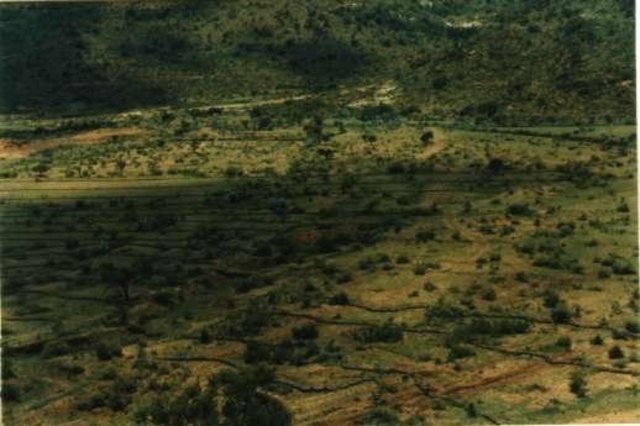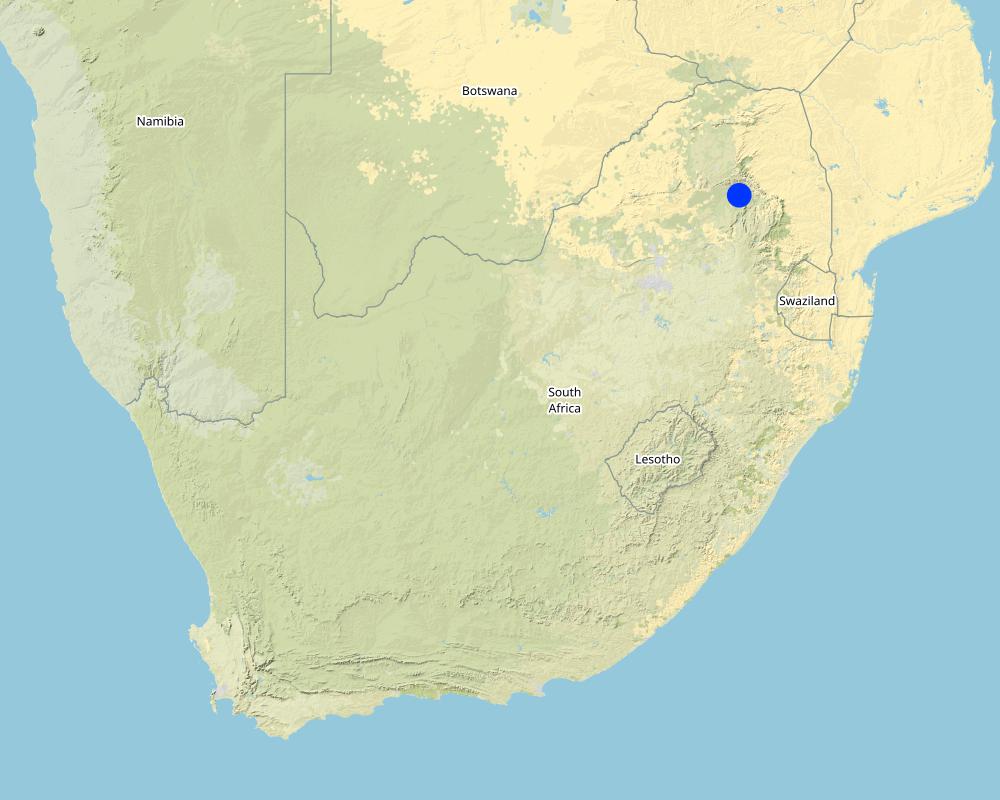Assistance to community [南非]
- 创建:
- 更新:
- 编制者: Philippe Zahner
- 编辑者: –
- 审查者: Fabian Ottiger, Joana Eichenberger
approaches_2548 - 南非
查看章节
全部展开 全部收起1. 一般信息
1.2 参与方法评估和文件编制的资源人员和机构的联系方式
有助于对方法进行记录/评估的机构名称(如相关)
Swiss Agency for Development and Cooperation (DEZA / COSUDE / DDC / SDC) - 瑞士1.3 关于使用通过WOCAT记录的数据的条件
编制者和关键资源人员接受有关使用通过WOCAT记录数据的条件。:
是
1.4 SLM技术问卷的参考

Old Motor Tyre Contours [南非]
Old motor tyres and/or vegetation along contours.
- 编制者: Andrei Rozanov
2. SLM方法的描述
2.1 该方法的简要说明
Community requested assistance to combat soil erosion, only possible when 'Drought Relief Funds' became available.
2.2 该方法的详细说明
该方法的详细说明:
Aims / objectives: During the national drought of 1992, the Government made funds available for job creation to temporarily alleviate poverty in the rural areas. This community, with a population of approximately 4000, applied for funds, and suggested that the funds be used to combat soil erosion within their communal area of 3800 ha. The area was inspected by technicians from the then Lebowa Government: Directorate Agricultural Engineering, and a project site was identified where both proven high technology methods, as well as novel and unproven low technology biological methods, which can easily be adopted by relatively unskilled workers from the community, could be tried. Work started in 1992 with sufficient funds for six months. Fortunately, for the project, the national drought continued and funds were made available again during the subsequent three years for six monthly periods. No work has been done on the project since 1996 because of a lack of funds. In view of the visible improvement of the environment, the community is keen to expand the project to include more techniques to make the project more viable. The project has proved to be highly educational, not only to the local community, but also to all other communities who have visited the project. A prime example is that of the two communities from the Western Region who have adopted and adapted similar techniques at their own projects.
2.5 采用该方法的国家/地区/地点
国家:
南非
区域/州/省:
Sekhukhuneland, Northern Province
Map
×2.6 该方法的开始和终止日期
注明开始年份:
1992
2.7 方法的类型
- 基于项目/方案
2.8 该方法的主要目的/目标
The Approach focused mainly on SLM with other activities (Job creation. Empower the community to practice conservation, increase production of their natural resources and to improve their quality of life. Improve biodiversity. Demonstration model for researcher & other communities.)
Rehabilitation of the environment by trapping run-off rain water to plant trees, grass and other vegetation to improve the general biodiversity.
The SLM Approach addressed the following problems: Soil degradation caused by water erosion as a result of over utilisation.
2.9 推动或妨碍实施本办法所适用的技术的条件
财务资源和服务的可用性/可得性
- 阻碍
government job creation funds
Treatment through the SLM Approach:
法律框架(土地使用权、土地和水使用权)
- 启动
The existing land ownership, land use rights / water rights helped a little the approach implementation: help and hinder low, n/a
了解SLM,获得技术支持
- 阻碍
department of agriculture
Treatment through the SLM Approach:
3. 相关利益相关者的参与和角色
3.1 该方法涉及的利益相关者及其职责
- 当地土地使用者/当地社区
existing groups of land users; Specific ethnic groups:: Only one group in area.; Working land users were work equally divided between men and women
Involvment of socially and economically disadvantaged groups: With discussion, the Phaahla Mohlaka tribe.
- 国家政府(规划者、决策者)
Department of Agriculture - Engineering Division.
如果涉及多个利益相关者,请注明领导机构:
University of the North, Department of Agriculture
3.2 当地土地使用者/当地社区参与该方法的不同阶段
| 当地土地使用者/当地社区的参与 | 指定参与人员并描述活动 | |
|---|---|---|
| 启动/动机 | 互动 | Mainly:public meetings; partly: rapid/participatory rural appraisal; Community meeting never regularly, meeting as often as needed, on side participation. |
| 计划 | 互动 | rapid/participatory rural appraisal; The specialists planned and discussed it with the people |
| 实施 | 互动 | Mainly: casual labour; partly: responsibility for major steps; The specialists planned and discussed it with the people |
| 监测/评估 | 互动 | measurements/observations; Observation by technical staff, regularly reporting to the Department |
| Research | 被动 | on-farm; Continuous contact while working on the project. |
3.4 有关SLM技术选择的决策
具体说明谁有权决定选择要实施的技术:
- 主要是SLM专家,咨询土地使用者之后
解释:
consultative. Suggestions are made by technical staff to the local community for ratification.
Decisions on the method of implementing the SLM Technology were made by mainly by SLM specialists with consultation of land users. consultative. Mutual discussion between technical staff and local community.
4. 技术支持、能力建设和知识管理
4.1 能力建设/培训
是否为土地使用者/其他利益相关者提供培训?:
是
明确受训人员:
- 土地使用者
培训形式:
- 在职
涵盖的主题:
People were instructed how to do the job, but not real training.
4.2 咨询服务
土地使用者有权使用咨询服务吗?:
是
说明/注释:
Name of method used for advisory service: Government extension staff; Key elements: Range land management; 1) Advisory service was carried out through: Government's existing extension system 2) Advisory service was carried out through: Government's existing extension system; Extension staff: Mainly government employees
Advisory service is inadequate to ensure the continuation of land conservation activities; Too few officers adequately conversant with SWC.
4.3 机构强化(组织发展)
是否通过这种方法建立或加强了机构?:
- 否
4.4 监测和评估
监测和评估是该方法的一部分吗?:
是
注释:
bio-physical aspects were ad hoc monitored through observations
technical aspects were regular monitored through observations
There were several changes in the Approach as a result of monitoring and evaluation: 1) Grass growing where there were none. 2) Numbers of grass species have increased considerably. 3) Gullies are stabilizing. 4) Water run off reduced.
4.5 研究
研究是该方法的一部分吗?
是
明确话题:
- 技术
提供进一步的细节,并指出是谁做的研究:
Determine sediment deposit and erosion control of the techniques.
Research was carried out on-farm
5. 融资和外部物质支持
5.1 该方法中SLM组成部分的年度预算
如果不知道准确的年度预算,请给出一个范围:
- 10,000-100,000
注释(例如主要的资助来源/主要捐助者):
Approach costs were met by the following donors: government (national - Government Drought Relief): 100.0%
5.2 为土地使用者提供财政/物质支援
土地使用者是否获得实施该技术的财政/物质支持?:
是
如果是,请具体说明支持的类型、条件和提供者:
A daily wage is paid by means drought relief job creation.
5.3 对特定投入的补贴(包括劳动力)
注释:
A daily wage is paid by means drought relief job creation.
5.4 信用
是否根据SLM活动的方法给予信用值?:
否
6. 影响分析和结论性陈述
6.1 方法的影响
该方法是否帮助土地使用者实施和维护SLM技术?:
- 否
- 是,很少
- 是,中等
- 是,支持力度很大
该方法是否改善了阻碍SLM技术实施的土地使用权/用户权问题?:
- 否
- 是,很少
- 是,中等
- 是,支持力度很大
The problem is unlikely to be overcome in the near future. Because of no individual ownership
Did other land users / projects adopt the Approach?
- 否
- 是,很少
- 是,中等
- 是,支持力度很大
Too early to comment.
6.3 方法活动的可持续性
土地使用者能否维持通过该方法实施的措施(无外部支持的情况下)?:
- 否
若否或不确定,请具体说明并予以注释:
It is a social problem, cause in human nature.
6.4 该方法的长处/优点
| 土地使用者眼中的长处/优势/机会 |
|---|
| improvement of the general economic situation (How to sustain/ enhance this strength: Expanding it) |
| increase job creation (How to sustain/ enhance this strength: But only for a short time) |
| 编制者或其他关键资源人员认为的长处/优势/机会 |
|---|
| At the beginning the workers regarded the work mainly as a source of income (How to sustain/ enhance this strength: Lack of understanding. After some rain had fallen that they came to realise what was being accomplished, and their enthusiasm grew steadily from that time.) |
| increase job creation (How to sustain/ enhance this strength: But only for a short time) |
| improvement of the general economic (How to sustain/ enhance this strength: Expanding it) |
6.5 该方法的弱点/缺点以及克服它们的方法
| 土地使用者认为的弱点/缺点/风险 | 如何克服它们? |
|---|---|
| lack of funds | |
| no individual benefits for the local |
| 编制者或其他关键资源人员认为的弱点/缺点/风险 | 如何克服它们? |
|---|---|
| no individual benefits for the local | Land tenure |
| lack of funds | Find more funds |
7. 参考和链接
7.1 方法/信息来源
- 实地考察、实地调查
- 与土地使用者的访谈
7.2 参考可用出版物
标题、作者、年份、ISBN:
Preliminary Report Geen Einde.Request for funding.Geen Einde - Trees planted so far.
可以从哪里获得?成本如何?
C.W. SpiesC.W. SpiesC.W. Spies
链接和模块
全部展开 全部收起链接

Old Motor Tyre Contours [南非]
Old motor tyres and/or vegetation along contours.
- 编制者: Andrei Rozanov
模块
无模块


